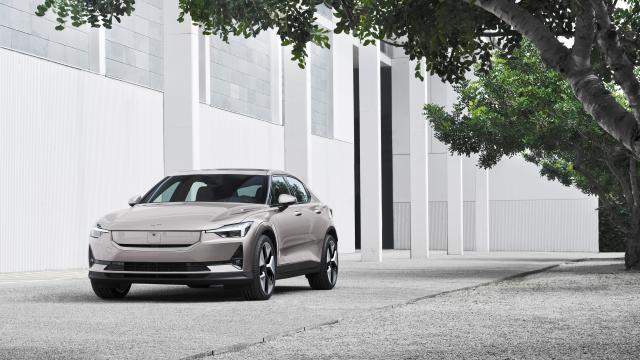
Model mid-cycle upgrades usually consist of faffing about with design features and tweaking, or adding, the odd piece of automotive technology.
Surprisingly, Polestar 2, the Swedish designed sedan, via Volvo, made in China, has really set about its two-year-old EV.
As the maker puts it, the electric car’s range, efficiency, and performance have been improved, at the same time with a cut in carbon footprint. Putting figures to that, the Polestar 2, with larger batteries and new motors, can now travel up to 22 per cent further, consume up to nine per cent less energy and charge up to 34 per cent faster.
A new look is in line with Polestar 3 and Polestar 4 models and includes a switch from front to rear-wheel drive for the base variants. All versions have been boosted with longer range and active safety equipment as standard. Prices are up between $3000 and $4000 before on-road costs.
The base model Standard Range Single Motor rear-wheel drive comes to market from $67,400, plus on-road costs, the Long Range Single Motor RWD sells from $71,400, plus on-roads and the Long Range Dual Motor AWD tops off the trio at $76,400.
A Performance Pack, consisting of a software upgrade, Performance suspension settings, with Ohlins shock absorbers, 20-inch alloy wheels, gold tyre valve caps and gold seatbelts can be had for $9000. On test were the Standard Range Single Motor RWD and flagship Long Range Dual Motor AWD, the latter with Performance Pack.
STYLING
If it looks like a Volvo and behaves like a Volvo, then it probably is a Volvo. Likewise, with its Volvo roots, little has changed along the way on the styling front from the first Polestar 2 iteration.
INTERIOR
The steeply raked slit-of-a rear window presents tight headroom and a limited view behind for the driver, but the panoramic glass roof really opens up the cabin for occupants with its tinted panel keeping out the hot sunrays.
However, the absence of a retractable solid material blind in the test vehicle failed to keep the summer sun’s heat at bay. Also the climate controls are operated through the touchscreen, which can make comfort doubly difficult during a bumpy ride.
Legroom is adequate for a vehicle of this size, as is shoulder space. There are a couple of Isofix child restraint anchor points in the back and a child seat can be clipped in the middle thanks to a top tether point in the lower section of the seat.
An under-bonnet cubby can easily house the charging lead, while the rear boot can take 405 litres with nifty ‘grocery gate’, a divider that has elastic bands to prevent smaller items from tumbling around. A useable 41 litre sub floor keeps stuff hidden.
Like with other EVs, you can forget a spare wheel.
INFOTAINMENT
The dual 12.3-inch screens provide stacks of info and once mastered, over time, is quick, responsive and fairly easy to navigate.
Bluelink connected car service allows users to set a charging time, and pre-set the vehicle’s climate control to take advantage of off-peak electricity; also remotely monitor the vehicle’s distance to empty and can restart charging if required.
The app allows the owner to find EV charging stations and send the address to the car’s sat nav. A tool will show on a map the driveable radius with 80 and 100 percent battery charge levels.
Wireless phone charging is standard across the range. Apple CarPlay and Android Auto are wired, with Google and Android functions on tap. A 600W harman/kardon audio system has 13 speakers spread around the cabin but there’s no access to AM radio.
ENGINES/TRANSMISSIONS
The single motor versions are powered by a newly developed permanent magnet unit and silicon carbide inverter putting out up to 220 kW and 490 Nm. In the dual motors, the rear one is the primary drive source, with support from up front by a new synchronous unit. Total power output is 310 kW and 740 Nm.
The Performance software upgrade boosts power by 40 kW to 350 kW and torque to 740 Nm.
SAFETY
Polestar 2 carries over the five-star ANCAP safety rating from its debutant model.
Driver and passengers are ‘cushioned’ by eight airbags.
Value added across the range comes from active safety features such as blind spot warning and cross traffic alert, both with brake support, rear collision warning and mitigation, along with 360-degree surround view camera and dimming exterior mirrors.
The SmartZone also incorporates some of the vehicle’s most important active safety features, including a front-facing camera and mid-range radar.
DRIVING
The move to rear-wheel drive with the single motor in the MY24 Polestar 2 makes for a more pleasing drive over the front-drive model, while the rear-wheel drive bias of the all-wheel drive model has a similar effect.
The single motor model rear-wheel drive appeared more spritely than its all-wheel drive cousin, probably due to its carrying less weight. However, in one-pedal drive mode, regenerative braking in the latter is less sharp, an intentional move, says the manufacturer, if the electric motor slows the rear wheels too quickly, it risks putting the vehicle in a spin.
The Performance Pack used its race-developed four-piston Brembo brakes to pull up the weighty (2 tonne-plus) vehicle to a halt assuredly. However, the tweaked suspension and low profile tyres picked up even the slightest blemish in the bitumen.
As far as efficiency is concerned, the front motor of the latter can be shut down when not needed and re-engaged when more power is required, something that came to light during testing with the need to accelerate suddenly in a roundabout filtering move that could have ended not well.
Energy consumption on tests were, for the flagship 19.6 kWh/100km and the single motor 16.5 kWh/100km, compared to the maker’s claims of 17.2 kWh/100 km and 14.8 kWh/100km, respectively.
The Standard Range Single Motor is capable of a range of 532 kilometres, says the maker, depending on how the car is driven, while the Long Range Single Motor (on test) pushes that out to 654 kilometres.
An overnight charge at home via a standard plug-in system put around 30 per cent into the battery of the single motor model, while fast charging of the dual motor did roughly the same in 30 minutes.
The MY24 Polestar 2 cars on test came up with a few surprises, some good, some not so. Reversing out of home, the autonomous emergency braking system picked up a low growing bush encroaching onto the curved driveway and instantly brought the car to a sudden halt, with an accompanying shock to the driver. A temporary tieback defeated the Triffid.
Reversing, generally, was a chore, with the distorted camera view making it difficult to judge distances.
On the more pleasant side, a family visit west had us all smiling. A battery top-up was sought in the south-east Queensland town of Warwick, which boasts a single public service point. Now, there may be only limited access to the service, but courtesy of Southern Downs Regional Council and the University of Queensland, filling up there is F-R-E-E.
SUMMARY
The dilemma for would-be Polestar 2 buyers is whether he or she should snap up the upgraded version at present prices or wait for the soon-to-be released
completely new version at what cost?
RATINGS
Looks: 7/10
Performance: 8/10
Safety: 8/10
Thirst: 8/10
Practicality: 6/10
Comfort: 7/10
Tech: 7/10
Value: 7/10






